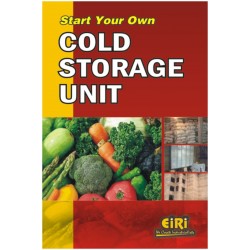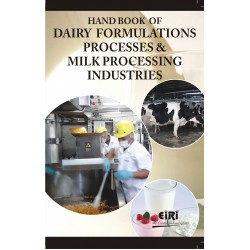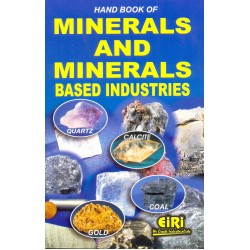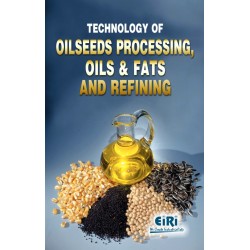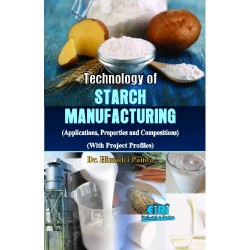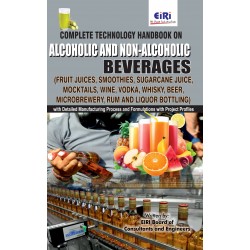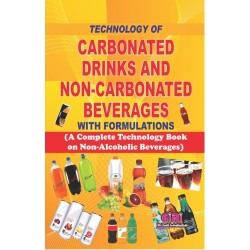Manufacturing Technology Hand Book of Gin, Rum, Whisky, Distillery Spirits, Brandy, Fruit Spirits, Flavours, Maturation and Blending with other Alcoholic Beverages (A Complete Hand Book on Distilled Spirits)

- More than 40 years of experience
- Managed by expert industrial consultants
- ISO 9001-2015 Certified
- Registered under MSME, UAM No: DL01E0012000
- 24/5 Research Support
Get your quesries resolved from an industry expert. Ask your queries before report or book purchase. - Custom Research Service
Speak to the our consultant to design an exclusive study to serve your research needs. - Quality Assurance
All reports are prepared by highly qualified consultants & verified by a panel of experts. - Information Security
Your personal & confidential information is safe & secure.
The book Manufacturing Technology Hand Book of Gin, Rum, Whisky, Distillery Spirits, Brandy, Fruit Spirits, Flavours, Maturation and Blending with other Alcoholic Beverages (A Complete Hand Book on Distilled Spirits) covers Distilled Spirits, Rum, Whiskey, Manufacturing of Malt Whiskies, Processing of Grain Whisky, Grain Distillery Processing, Yeast and Fermentation, Flavour Production During Fermentation, Batch Distillation, Maturation and Blending, Cereal Based Spirit Technology, Cane Spirits, Vegetable Based Spirits and Aniseed Flavored Spirits, Brandy, Grape and Other Pomace Spirits, Fruit Spirits, Liqueurs and Their Flavorings, Plant Economics of Indian Made Foreign Liquor, Plant Economics of Alcohol from Potato, Plant Economics of Beer Industry, Plant Economics of Rectified Spirit, Plant Economics of Bottling Plant (Country Liquor), Plant Economics of Bottling of Whisky, Plant Economics of Distillery, Plant Economics of Mlanufacture of Distilled Spirits and Alcoholic Beverage, Plant Economics of Bottling Plant (Whisky, Brandy, Rum, Vodka, Gin) from Rectified Spirit/ENA, Plant Economics of Grain Based Alcohol Distillery.
Distilled spirit, also called distilled liquor, distilled spirit fermentation and distillation process for producing whiskey (Credit. Encyclopaedia Britannica, Inc. Jalcoholic beverage (such as brandy, whisky, run, or arrack) that is obtained by distillation from wine or other fermented fruit or plant juice or from a starchy material (such as various grains) that has first been brewed. The alcoholic content of distilled liquor is higher than that of beer or wine.
The production of distilled spirits is based upon fermentation, the natural process of decomposition of organic materials containing carbohydrates. It occurs in nature whenever the two necessary ingredients, carbohydrate and yeast, are available. Yeast is a vegetative microorganism that lives and multiplies in media containing carbohydrates particularly simple sugars. It has been found throughout the world, including frozen areas and deserts.
Distilled spirits are all alcoholic beverages in which the concentration of ethyl alcohol has been increased above that of the original fermented mixture by a method called distillation. The principle of alcoholic distillation is based upon the different boiling points of alcohol (78.5oC, or 173.3oF) and water (100 0C, or 212oF). If a liquid containing ethyl alcohol is heated to a temperature above 78.5 oC but below 100 oC and the vapour coming off the liquid is condensed, the condensate will have a higher alcohol concentration, or strength.
The book contains the following 26 chapters on distilled Spirits, Rum, Whiskeys, Manufacturing of Malt Whiskies, Processing of Grain Whisky, Grain Distillery Processing, Yeast and Fermentation, Flavour Production During Fermentation, Batch Distillation, Maturation and Blending, Other Cereal Based Spirits, Cane Spirits, Vegetable Based Spirits and Aniseed Flavored Spirits, Brandy, Grape and other Pomace spirits, fruit spirits, liqueurs and their Flavourings, Plant Economics of Indian Made Foreign Liquor, Plant Economics of Alcohol From Potato, Plant Economics of Beer Industry, Plant Economikcs of Rectified Spirit, Plant Economics of Bottling Plant (Country Liquor), Plant Economics of Bottling of Whisky, Plant Economics of Distillery, Plant Economics of Manufacture of Dikstilled Spirits and Alcoholic Beverage, Plant Economics of Bottling Plant (Whisky, Brandy, Rum, Vodka, Gin) from Rectified Spirit/ENA, Plant Economics of Grain Based Alcoholic Distillery.
DISTILLED SPIRITS
- Gin
- Unique Bombay Sapphire Distillation Process
- Intinct
- Simplified diagram showing the production of compound of compound gin
- Example recipe for compound gin
- Juniper (Juniperus communis)
- Recipes
- Basic Gin
- British Gin
- Cordial Gin
- Cordial Gin
- Fine Gin
- London Gin
- Basic Geneva
- Plain Geneva
- Fine Geneva (highly recommended)
- English Geneva
- Botanical names
- Ternivka (Sloe Vodka)
- Damson Gin
- Pacharan is a Spanish liqueur
- Production
- Botanicals used in production of gin
RUM
- Grades
- Production method
- Aromatic Compounds Present in Molasses
- Pre treatments
- Clarification
- Dilution with water and nutrient addition
- Composition of the Mash after Molasses Pretreatments
- Fermentation Conditions
- Yeast
- yeasts Isolated from Molasses or Cane Juice
- Desirable Properties of Distilling Yeast
- Fermentation Rate and Efficiency
- Embden Mayerhof Pamas Pathway of Glycolysis
- Environment
- Bacteria
- Centrifugation
- Distillation
- Pot still Distillation
- Continuous Distillation
- Example of a 3 Distillation Column System for Rum
- Aging
- Oak Wood for Maturation
- Contribution of Oak to the Aroma of Rum
- Compounds Identified in Oak Wood
- Reactions of Lignin components During Storage in 60% Ethanol Solutions
- Flavor of Rum
- Higher Alcohols
- Pathways for Lignin Derived Compounds Formation
- Diagram of the Formation of Higher Alcohols in Yeast Cells
- Higher Alcohols in Rum
- Organic Acids
- Esters
- Fatty Acids Present in Rum
- Aromatic and other Carboxylic Acids Identified in Rum
- Esters of Aliphatic Monocarboxylic Acids in Rum
- Carbonyl Compounds
- Carbonyl Compounds in Rum
- Acetals
- Formation of Acetal
- Phenols
- Volatile Phenols Identified in Rum
- Odor Perception
- Persistence of Odors
- In cusine
WHISKEYS
- Irish Whiskey
- Five basic categories of Irish whiskey
- The Whiskeys of America
- Bourbon and Tennessee Whiskey
- The six most aroma active compound of Bourbon whiskey
- Anatomy of a whiskey cask and close up sketch of a stave top, showing where the cask head fits
- American Rye and Corn Whiskies
- Whiskies from Other Countries
- Canada
- Japan
- Idia
- Classification of Indian made whisky
- Europe
MANUFACTURING OF MALT WHISKIES
- Raw materials and processing
- Air
- Water
- Water sourcing
- Methods of pre treatment of water
- Sources of water and their characteristics
- Required characteristics of water for a malt whisky distillery supply characteristics
- Methods of pre treatment of water
- Process of sterilizing water
- Water usage
- Production (mashing) water
- Product water
- Entry routes of production water
- Process water
- Service water
- Water conservation
- Procurement of Barley
- Ways of reducing water usage in malting and malt distilling
- Barley harvesting and drying
- Storage, cleaning and grading of Barley
- Quality control
- Control of barley variety
- Control of barley storage, cleaning and grading
- Control of viability
- Control of domancy
- Control of pregermination
- Control of total nitrogen content and corn size, and extract prediction tests
- Peat
- Malting Technology
- Steeping of barley
- Barley grain structure
- Germination
- Science of germination
- respiration and growth
- Moisture control
- Fermentability
- Technology of germination
- Separate steeping, germination & kilning
- Combined germinating and kilning vessels
- Combined steeping, germination and kilning vessels
- Kilning
- Science of kilning
- Sulphur dioxide
- Nitrosamines
- Flavours
- The effect of kilning on malt bacteria
- Yeast nutrients
- Malt rootlets (culms)
- The technology of kilning
- Separate kins
- GKV and SKGV kilns
- Nitrosamine control
- Peating
- Malt
- Malt specification for Scotch malt whisky
- Moisture
- Friability
- Typical malt distilling malt specification
- Fermentability
- Phenols
- Sulphur dioxide and nitrosamines
- Milling, mashing and wort recovery
- The science of milling, mashing and wort recovery
- Technology of milling, mashing & wort recovery
PROCESSING OF GRAIN WHISKY
- Raw materials
- Maize
- Wheat
- Wheat specifications
- Wheat breeding
- Barley
GRAIN DISTILLERY PROCESSING
- General overview of process and principles
- Processing options used in Scotch whisky grain distilleries
- The main features of what might be regarded as a typical grain distillery process
- Starch structure
- Gelatinization
- Composite photograph showing the phase changes that occur in cereal starch granules as they undergo gelatinization
- A schematic representation showing the main features of a pasting curve produced by a Rapid Visco Analyser
- The cooking process
- Milling
- Cooking
- Principles of cooking
- Cooking in the grain distillery
- Range of cooking conditions operated at different Scotch grain whisky distilleries
- Blow down and retrogradation
- Retrogradation of starch
- Problems with cooking
- Conversion
- Principles of conversion
- Starch hydrolysis
- Degradation of starch by a and B amylase
- Proteolysis
- Wort separation
- Future developments
- Wort filtration in a grain distillery
YEAST AND FERMENTATION
- Yeast for alcohol fermentation
- Yeast biochemistry
- Products of yeast fermentation
- Fermentability of wort
- Yeast structures
- Principal structures of an aerobically grown cell of distilling yeast Saccharomyces cerevisiae
- BS, bud scar, CW cell wall, CM cytoplasmic membrane (cell membrane), Mt. mitochondrion, N nucleus, V. vacuole
- Carbohydrate metabolism
- Approxijmate sugar composition of all malt wort, expressed as percentage of total carbohydrate
- Transport of fermentable sugars into Saccharomyces cerevisiae F fructose G, glucose, GP, glucose phosphate, M2 maltose M3 maltotriose
- S, sucrose, CW cell wall CM, cytoplasmic membrane
- Summary of Embden Meyerholf Parnas metabolic pathway
- Nitrogen metabolism
- Classification of amino acids by their rate of absorption from wort
- Biosynthesis of amino acids or higher alcohols by Saccharomyces cerevisiae, Pathways generate an excess of ATP or oxidized NAD
- Structural relationship between amino acids and higher alcohols
- Relationship of valine biosynthesis to formation of isobutanol and diacetyl.
- Fatty acid and ester production
- Sulphur metabolism
- Formation of esters by recycling of coenzyme A
- Formation of esters and fatty acids as byproducts of yeast growth
- oxygen metabolism
- Formation of sulphur compounds as byproducts of synthesis of sulphur containing amino acids
FLAVOUR PRODUCTION DURING FERMENTATION
- Factors affecting ester and higher alcohol production by yeast
- Cultivation of distillery yeast
- Rotary vacuum dryer for filtration of distillery yeast
- Progress of fermentation
- Design of fermentation vessels
- Yeast quantity and quality
- Production of carbon dioxide
BATCH DISTILLATION
- Design of distillery
- Heating source
- Pot
- Still design configuration
- Swan neck
- head
- Lyne arm
- Worm tub or condenser
- Spirit safe
MATURATION AND BLENDING
- Cooperage oak wood
- Structure of wood
- Cask manufacture
- Timber processing
- Stave cuts in timber processing
- Bourbon cask construction
- Sherry cask construction
- Heat treatment chemistry
- Degradation of wood polymers to yield flavour compounds
- Destruction of resinous or unpleasant aroma in the wood
- Production of a iayer of active carbon on the inner surface of casks
- Control of heat treatment
- Cask regeneration
- Scotch whisky maturation
- Maturation reactions
- Additive activity
- Subtractive activity
- Evaporation
- Adsorption/degradation by char
- Chemical degradation
- Masking
- Cask types
- Maturation in new charred casks
- Maturation in ex sherry casks
- Maturation in ex-bourbon casks
- Maturation in refill casks
- Maturation in regenerated caska
- Other maturation variables
- Maturation time
- Fill strength
- Warehousing
- Warehouse types
- Environmental conditions and evaporative losses
- Effects on quality
- Wood policy
- Blending
- Why blend
- What does blending involve
- The flavour specialist
- The role of malt whiskies in the blend
- The role of grain whiskies in the blend
- Ratio of grain to malt whisky
- Assessment of whiskies to be used in the blend
- Strategy
- Practicalties of blending
- Innovation
- Blending of whiskies other than Scotch
CEREAL BASED SPIRITS TECHNOLOGY
- Akvavit (Aquavit) and Vodka
- Formulations for (a) Akvavit and (b) flavoured vodka
- Asian Grain Spirits
- Distilled Spirits of China, Korea and Japan
- Chinese Liquors
- Basic outline of Chinese liquor manufacture
- Some well known Chinese liquors
- Japanese Shochu and Related Spirits
- Types of shochu
- Korean Soju and Related Spirits
- Mechanism for the conversion of ferulic acid in awamori and Shochu
CANE SPIRITS, VEGETABLE BASED SPIRITS AND ANISEED FLAVORED SPIRITS
- Arrack, Mezcal and Tequila
- Simplified scheme for the production of mezcal and tequila
- Aniseed flavored Spirits
- Simplified diagram for the production of ouzo
BRANDY
- The Base (Rebate) Wine
- Requirements set for quality wine that is to be used as pot still brandy
- Compounds that Influence the Quality of Brandy
- The Distillation
- Pot still setup for batch distillation
- Double pot still at the University of Stellenbosch, South Africa for small scale continuous or batch distillation (b) Close up of boiler, showing oil heater unit below and condenser on the left
- The First Distillation (Brouillis Production)
- The Second Distillation (La Bonne Chauffe)
- Effects of Distillation
- Continuous Distillation
- Coopering & Maturation
- Compounds that can be extracted from oak extracted from oak during the maturation of brandy
- Blending
- Cognac
- Armagnac
- Other Brandies
- Spain and Other Souther European Countries
- The United States
- South Africa
- Pisco
- Quality Control in Brandy Production
GRAPE AND OTHER PO9MACE SPIRITS
- Production of Pomace Spirits
- Types of Pomace Spirits and Sensory Characteristcs
FRUIT SPIRITS
- Apple and Pear Spirits
- Cider spirit and Calvados stil
- Other Fruit Spirits
LIQUEURS AND THEIR FLAVORINGS
- Fruit and Fruit Flavored Liqueurs
- Examples of fruit liqueurs and liqueurs of the Curacao type
- General scheme for fruit liqueur and fruit flavoured liqueur production
- General scheme for the production of a Curacao style liqueur
- Flower, Herb, Spice and Bitter Liqueurs
- Characteristic coumarins and psoralens in authentic limoncello liqueur
- Scheme for the production of a monastery type herb liqueur
- Cocoa, Coffee and Tea Liqueurs
- Nut and Emulsion Liqueurs
- Production and Use of Essences and Concentrates
- Schematic diagram of a Soxhiet extraction device
PLANT ECONOMICS OF INDIAN MADE FOREIGN LIQUOR
- Plant & Machinery
- Fixed Capital
- Raw Materials
- Total Working Capital/Month
- Total Capital Investment
- Turn Over/Annum
PLANT ECONOMICS OF ALCOHOL FROM POTATO
- Plant & Machinery
- Fixed Capital
- Raw Materials
- Total Working Capital/Month
- Total Capital Investment
- Turn Over/Annum
PLANT ECONOMICS OF BEER INDUSTRY
- Plant & Machinery
- Fixed Capital
- Raw Materials
- Total Working Capital/Month
- Total Capital Investment
- Turn Over/Annum
PLANT ECONOMICS OF RECTIFIED SPIRIT
- Plant & Machinery
- Fixed Capital
- Raw Materials
- Total Working Capital/Month
- Total Capital Investment
- Turn Over/Annum
PLANT ECONOMICS OF BOTTLING PLANT (COUNTRY LIQUOR)
- Plant & Machinery
- Fixed Capital
- Raw Materials
- Total Working Capital/Month
- Total Capital Investment
- Turn Over/Annum
PLANT ECONOMICS OF BOTTLING OF WHISKY
- Plant & Machinery
- Fixed Capital
- Raw Materials
- Total Working Capital/Month
- Total Capital Investment
- Turn Over/Annum
PLANT ECONOMICS OF DISTILLERY
- Plant & Machinery
- Fixed Capital
- Raw Materials
- Total Working Capital/Month
- Total Capital Investment
- Turn Over/Annum
PLANT ECONOMICS OF MANUFACTURE OF DISTILLED SPIRITS AND ALCOHOLIC BEVERAGE
- Plant & Machinery
- Fixed Capital
- Raw Materials
- Total Working Capital/Month
- Total Capital Investment
- Turn Over/Annum
PLANT ECONOMICS OF BOTTLING PLANT (WHISKY, BRANDY, RUM, VODKA, GIN) FROM RECTIFIED SPIRIT/ENA
- Plant & Machinery
- Fixed Capital
- Raw Materials
- Total Working Capital/Month
- Total Capital Investment
- Turn Over/Annum
PLANT ECONOMICS OF GRAIN BASED ALCOHOL DISTILLERY
- Plant & Machinery
- Fixed Capital
- Raw Materials
- Total Working Capital/Month
- Total Capital Investment
- Turn Over/Annum
How to Make Project Report?
Detailed Project Report (DPR) includes Present Market Position and Expected Future Demand, Technology, Manufacturing Process, Investment Opportunity, Plant Economics and Project Financials. comprehensive analysis from industry covering detailed reporting and evaluates the position of the industry by providing insights to the SWOT analysis of the industry.
Each report include Plant Capacity, requirement of Land & Building, Plant & Machinery, Flow Sheet Diagram, Raw Materials detail with suppliers list, Total Capital Investment along with detailed calculation on Rate of Return, Break-Even Analysis and Profitability Analysis. The report also provides a birds eye view of the global industry with details on projected market size and then progresses to evaluate the industry in detail.
We can prepare detailed project report on any industry as per your requirement.
We can also modify the project capacity and project cost as per your requirement. If you are planning to start a business, contact us today.
Detailed Project Report (DPR) gives you access to decisive data such as:
- Market growth drivers
- Factors limiting market growth
- Current market trends
- Market structure
- Key highlights
Overview of key market forces propelling and restraining market growth:
- Up-to-date analyses of market trends and technological improvements
- Pin-point analyses of market competition dynamics to offer you a competitive edge major competitors
- An array of graphics, BEP analysis of major industry segments
- Detailed analyses of industry trends
- A well-defined technological growth with an impact-analysis
- A clear understanding of the competitive landscape and key product segments
Need Customized Project Report?
- Ask for FREE project related details with our consultant/industry expert.
- Share your specific research requirements for customized project report.
- Request for due diligence and consumer centric studies.
- Still haven't found what you're looking for? Speak to our Custom Research Team
About Engineers India Research Institute:
Note: We can also prepare project report on any subject based on your requirement and country. If you need, we can modify the project capacity and project cost based on your requirement.
Our Clients

Our Approach
- Our research reports comprehensively cover Indian markets (can be modified as per your country), present investigation, standpoint and gauge for a time of five years*.
- The market conjectures are produced on the premise of optional research and are cross-accepted through associations with the business players
- We use dependable wellsprings of data and databases. What's more, data from such sources is handled by us and incorporated into the report
Why buy EIRI reports?
- Our project reports include detailed analysis that help to get industry Present Market Position and Expected Future Demand.
- Offer real analysis driving variables for the business and most recent business sector patterns in the business
- This report comprehends the present status of the business by clarifying a complete SWOT examination and investigation of the interest supply circumstance
- Report gives investigation and top to bottom money related correlation of real players/competitors
- The report gives gauges of key parameters which foresees the business execution





















